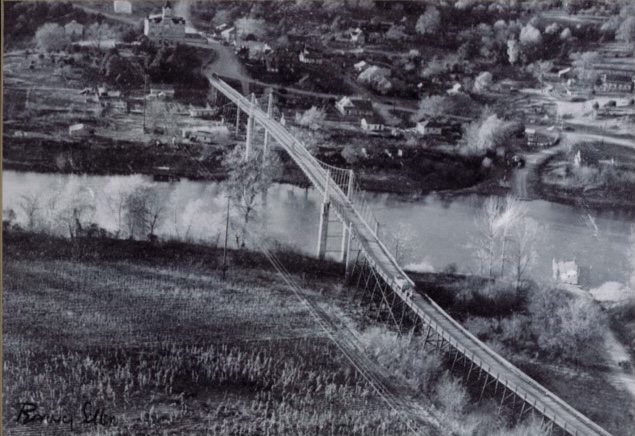The Powhatan Suspension Bridge was a toll bridge on the banks of the Black River that serviced pedestrians and vehicle traffic In Lawrence County from 1926 to 1951.
Powhatan became the seat of Lawrence County in 1869, and people from neighboring Walnut Ridge needed an efficient way to cross the Black River to attend to official business.
In the early 20th Century, with the increasing popularity of the automobile, it became clear that the old bridges of the 1800s were not enough to handle the weight of these new machines.
Bridge companies realizing that a new market had opened up deployed salesmen everywhere plying their trade. At that time there were no federal standards in place, bridge companies could design their project to fit each client’s individual situation.
The first mention of a bridge over the Black River was published in 1908, announcing that a bill had passed in the lower house of Congress.
Harry Bovay and his company called White River Bridge Company were granted permission to construct a bridge “at or near Black Rock” in 1925. Since 1906, any river or stream defined as a “navigable waterway” was subject to federal control, meaning anyone who wished to build a bridge had to get Congressional approval, and then secondary approval from the Secretary of War and the Chief of Engineers.
Construction began in late 1925 and was completed in 1926. The bridge was three hundred yards long, fourteen feet wide, and featured barriers four and a half feet tall made of wooden joists.
The bridge rose at a grade of fifteen to twenty degrees, which made a distinct arch.
Pedestrians were charged a nickel, automobiles one dollar.
River ferries in the area saw a decrease in business and filed lawsuits against the White River Bridge Company numerous times, the White River Bridge Company won each case. Travelers thought the rates were too high, and complaints on the issue led to a War Department hearing being held in Memphis in 1930, the rates for automobiles were eventually reduced to seventy-five cents, but public discontent over pricing remained.
The bridge at Powhatan became a target of newly elected governor Carl Bailey in 1937, eliminating toll bridges was one of his campaign promises.
The governor attempted to buy White River Bridge Company’s interest outright, offering to purchase the bridge along with another in Des Arc for $120,000, the owner demanded twice that amount.
Governor Bailey then deployed some unorthodox methods to attack the bridge indirectly. The state bought an existing ferry near Black Rock and made it free for public use. The state then put signs along the highway encouraging drivers to avoid the bridge.
Bovay and the White River Bridge Company sued the State of Arkansas and got an injunction prohibiting the establishment of any ferry within ten miles of the Powhatan bridge.
The State of Arkansas took the case to the Federal Court of Appeals and won. Bovay and the White River Bridge Company appealed the ruling, before the case could reach to the U.S. Supreme Court, the owner agreed to sell his final two bridges for $118,955: $68,000 the one at Powhatan and $50,000 for the one at Des Arc.
With that, toll bridges ceased to exist in Arkansas.
Congress later granted the Arkansas Highway Commission permission to build a highway bridge at Black Rock on July 25, 1939.
The ferry purchased by the state continued operation until the new Black Rock bridge was finished.
The Powhatan suspension bridge was dismantled in 1951. The columns of the former bridge still stand on each side of the river today.





